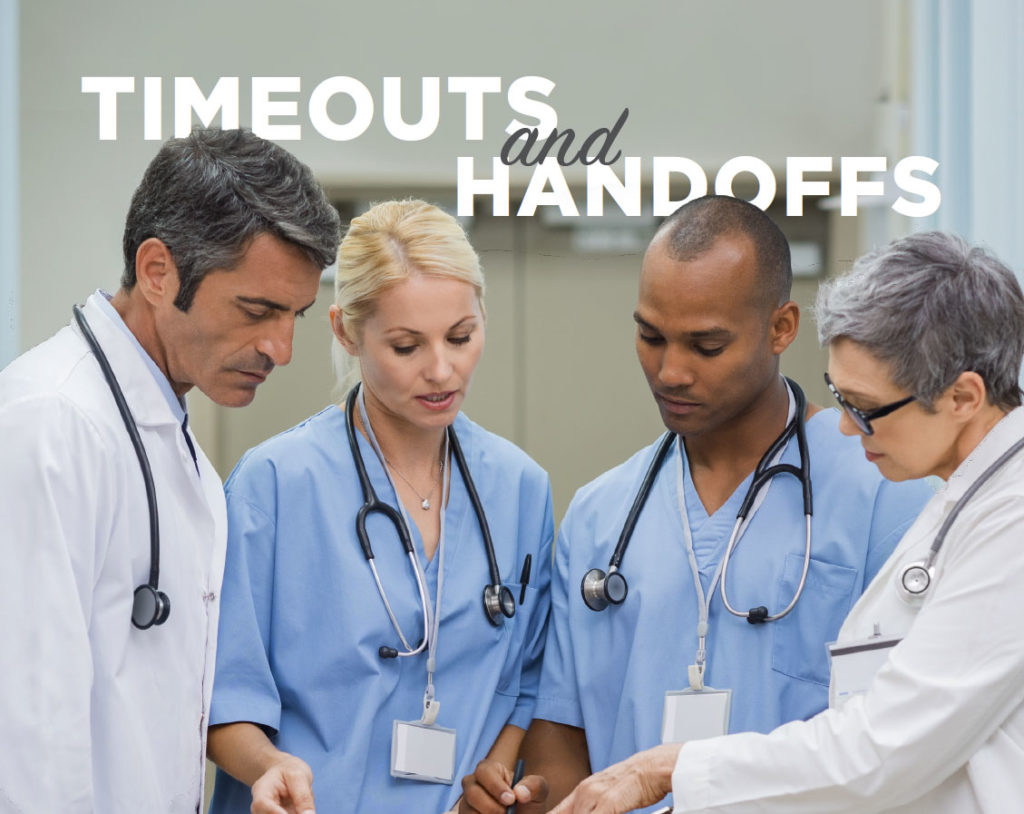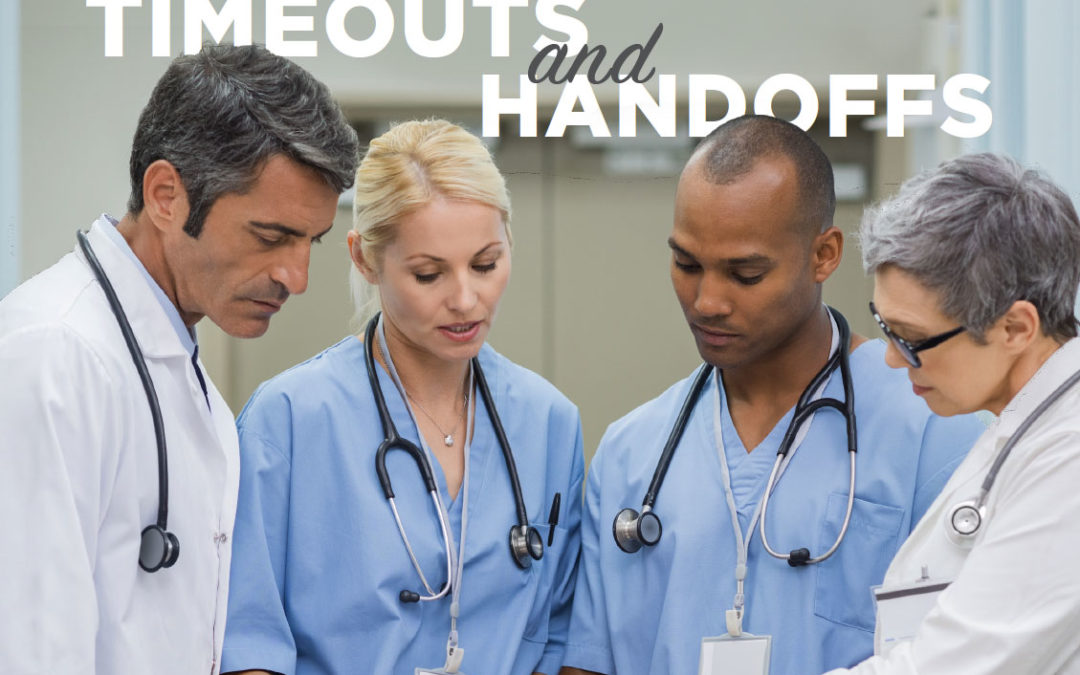
By Don Sadler
When most people hear the terms “time out” and “handoff,” they think of football. But these terms have very different meanings in the operating room.
In OR parlance, a time out is a pause that’s performed prior to the initiation of an operative or invasive procedure. The goal is to ensure that it is the correct patient, the consent form matches the procedure to be performed, and the procedure is being performed on the correct side. All activities should be stopped and all team members should participate in the time out.
A handoff is the transfer of a patient’s care from one practitioner to another. In the perioperative setting, a handoff occurs when the pre-operative preparation nurse hands off the patient to the OR circulator, when the OR circulator is relieved to go on a break or lunch, or at the end of the procedure when the circulator hands off the patient to the PACU RN.
Measure Twice, Cut Once
William J. Duffy, RN, MJ, CNOR, FAAN, program director, nursing and health care administration at the Marcella Niehoff School of Nursing at Loyola University of Chicago, has been a proponent of surgical time outs and handoffs for many years.
Duffy was instrumental in the creation of National Time Out Day and the Time Out Toolkit produced by the Association of periOperative Registered Nurses (AORN). When he appeared on the CBS morning show in 2004, Duffy described a surgical time out by comparing it to the old carpenter’s saying of “measure twice and cut once.”
“The time out process is our effort to stop and do a final check before we start the procedure on patients,” says Duffy.
According to Duffy, the word “time out” comes from the belief that “we need to step away from the multitude of tasks and focus for this minute on making sure we have the correct patient, the correct procedure and are working on the correct site. If every member of the team focuses on these questions before we begin, we can catch potential errors.”
The Joint Commission defines a handoff as “a transfer and acceptance of patient care responsibility achieved through effective communication. It is a real-time process of passing patient-specific information from one caregiver to another or from one team of caregivers to another for the purpose of ensuring the continuity and safety of the patient’s care.”
Inadequate handoff communication is a contributing factor to adverse events, including many types of sentinel events, according to The Joint Commission. A 2018 study found that nearly 30 percent of surgical adverse events occurring at Veterans Health Administration facilities could be attributed to an incomplete or incorrectly performed surgical time out.
Paul Wafer, BS, MBA, RN, says that in some organizations the surgeon takes the lead in initiating the time out while in others, the circulating nurse takes the lead. “During the time out, all other activities should be suspended so that all members of the perioperative team are paying attention,” says Wafer.
“All team members should introduce themselves and the patient should be verified using two patient identifiers,” Wafer adds. “The consent is then reviewed and the marking of the surgical site is confirmed.”
Other relevant information that Wafer says may be shared during the time out includes the fire risk assessment, confirmation of imaging, equipment concerns, the time of antibiotic prophylaxis, confirmation of sterilization indicators and any anticipated critical events by the surgeon.
“During time outs in our facility, the physician states the procedure and CRNAs confirm antibiotics,” says Erin Keeney, MSN, RN, CNOR, director of perioperative services at AnMed Health in Anderson, S.C. Other elements of the time out at AnMed Health include:
- Correct patient, site, procedure and laterality
- Team introduction
- Anesthesia review
- DVT prophylaxis
- Antibiotics given
- Any safety concerns
“Our nurses also use a handoff sheet to ensure that all important details about the patient are relayed to the next phase of care,” Keeney adds.
Standardizing Time Outs
Renae Wright, DNP, RN, CNOR, perioperative practice specialist with AORN, says that AORN recommends standardizing the time out process by using a checklist that has been customized to meet the needs of the facility.
“This gives members of the surgical team the opportunity to speak up and voice concerns if they notice something amiss,” says Wright. “The time out is intended to prevent medical errors involving wrong-site, wrong-procedure, wrong-patient or wrong-implant surgery.”
Wright cites data from The Joint Commission noting that among the main causes of wrong-site surgeries are ineffective handoff process, distractions or rushing that interfered with time outs and not having full participation in time outs.
“Communication is the foundation for both time outs and handoffs,” says Melanie Perry, BSN, RN, CNOR, the creator of The Circulating Life and co-host of the First Case podcast. “Taking the time to communicate properly prioritizes our patients and their safety and ensures the best surgical outcomes.”
For Wright, the saying “the buck stops here” comes to mind with regard to why time outs and handoffs are important.
“Most patients are under general anesthesia when these critical communication points occur so they are entirely dependent on the surgical team to keep them safe,” she says. “In other words, the buck stops with us.”
Like most perioperative professionals, Duffy says he has never seen any perioperative team intentionally perform a wrong-site or wrong-patient procedure. “But as the statistics show, this still happens even with the time out process,” he says.
“The human factor and our belief in our capabilities to manage the situation reduces our defense mechanism,” Duffy adds. “The fact that these errors don’t occur 99.9% of the time lulls us into security and we miss the .1% of the time they do happen, which can change both the patient and the practitioner’s lives forever.”
Normalizing Danger
The benefits of surgical time outs and handoffs seem obvious, which leads to the question: Why would perioperative teams not perform them before every surgery?
One obstacle is what Duffy calls the “normalization of danger.”
“It’s like the Allstate TV commercial where the actor says mayhem can happen at any time,” he says. “But we usually don’t think it can happen to our team in the OR.”
Establishing a culture of safety will help reduce the normalization of danger. “If we can keep staff members on the lookout for danger, they can better spot it and then take steps to prevent harm from happening,” says Duffy.
In her experience, Perry says that while time outs are always performed, they aren’t always done properly or with the appropriate level of involvement by all team members. “I’ve seen fully engaged teams perform a time out, and I’ve seen time outs be mostly ignored,” she says.
“Time outs work well when they’re standardized, prioritized and enforced by hospital leadership,” says Perry. “But it’s difficult to do the time out when the RN has to yell to get the team’s attention, when the surgeon wants to keep working while the time out is being performed or when the surgeon acts so annoyed that everyone has to stop.”
“Circulators are often frustrated that such an important safety measure is ignored or treated as unimportant,” Perry adds.
Wafer agrees that time outs are generally performed on a consistent basis.
“However, the quality of how and when they are performed varies widely across the country,” he says. “I have done assessments in over 40 states and the quality is not really based on geography as much as the culture of an individual organization.”
It has been nearly 20 years since the initiation of the surgical time out, notes Wafer, but there are still surgeons who feel it is a waste of time. “If this attitude emanates throughout the OR, it can be challenging to get all of the staff members to stand up to intimidation and bullying that can occur,” he says.
Wafer believes that overcoming this obstacle requires support from the very top of the organization. “It can be a real problem if the highest volume surgeon in a facility fights the time out,” he says. “Time outs have to be enforced even if a high-volume surgeon threatens to leave.”
Common Obstacles and Best Practices
One of the biggest obstacles to effective time outs and handoffs are distractions in the OR that lead to inattention among surgical team members, says Wright.
“During the time out and handoff, all music should be turned off, electronic devices including cellphones, tablets and computers should be silenced and conversations and all other activity suspended,” she says.
“Eliminating distractions and interruptions during the time out and handoff are critical so the team can focus on and comprehend the information being communicated, assess its accuracy and recognize any incongruencies,” Wright adds.
Duffy stresses the importance of performing a complete counting of surgical items (including instruments, needles, sponges and other devices) before a handoff. “It’s critical that the onboarding team member have an accurate count of which items have been placed on the field and where they are currently located,” he says.
“Also, whenever possible there should not be a complete changing of the original team,” Duffy adds. “The person who did the original count should be present throughout the procedure to help ensure no items are missed in the counting process.”
Wafer offers additional best practices for ensuring effective surgical time outs and handoffs:
- Develop a culture in which surgeons, nurses and technicians all reinforce the importance of time outs and handoffs. “You have to get everyone to buy in to these practices,” says Wafer.
- Standardize a script so the time out is done the same way by everyone in the organization.
- Create a checklist with all of the pertinent information that should be communicated to everyone in the room. “I like to use a whiteboard on the wall for this so if someone is relieved from the room, they can look at the whiteboard to verify all of the information,” says Wafer.
- Designate a physician champion who will address any variations in time out and handoff practices.
Evidenced-Based Recommendations
Wright encourages perioperative team members to consult the AORN Guideline for Team Communication when standardizing surgical time out and handoff procedures. “This contains evidence-based recommendations for developing time out and handoff process, implementation and monitoring quality,” she says.
The goal should be for time out and handoffs to become “hardwired habits” and “ingrained components” of the culture of safety within the organization, says Wright. “This will not only help keep patients safe from medical errors, but it will also help ensure that surgical team members don’t have to experience the trauma associated with sentinel events that can seriously harm patients.”
Keeney believes that having a strong patient safety culture and an engaged team, as evidenced by consistently performing thorough timeouts and handoffs, promotes exceptionalism.
“You and the team are all on the same page when caring for your patients,” she says. “Patients put their trust in us and it is our responsibility to keep them safe during their procedures and through all phases of care.”









